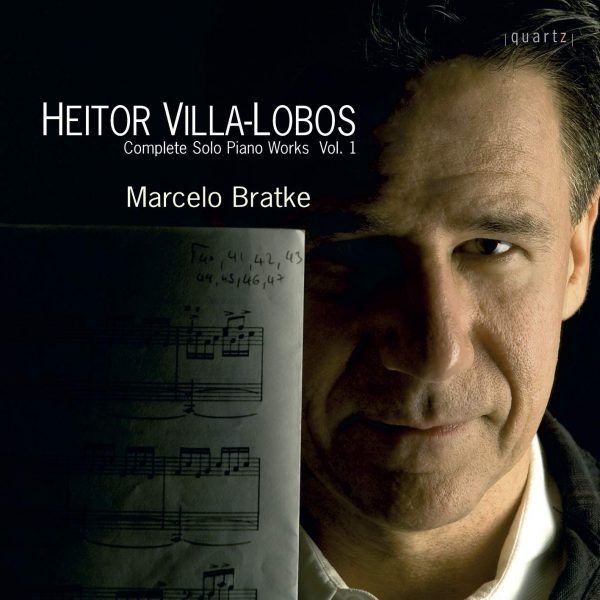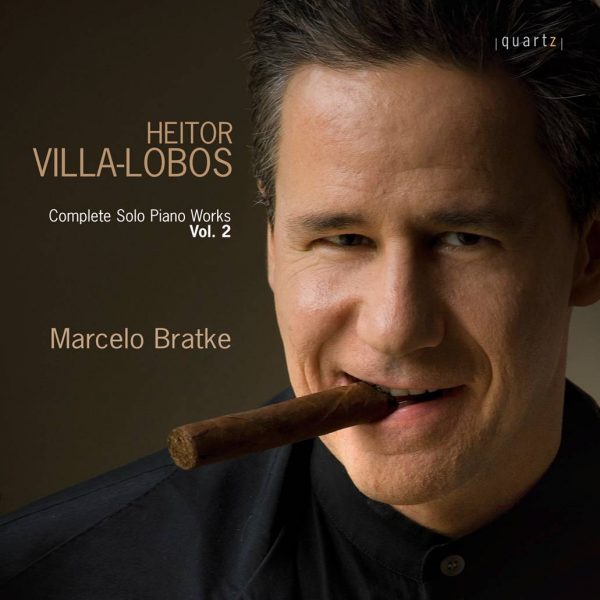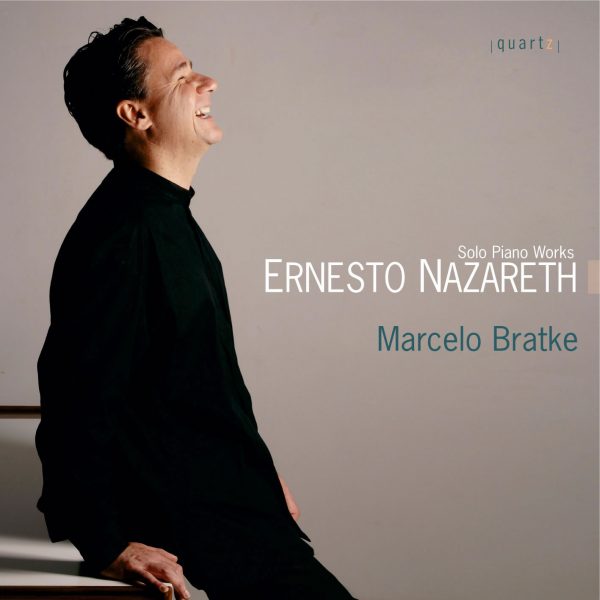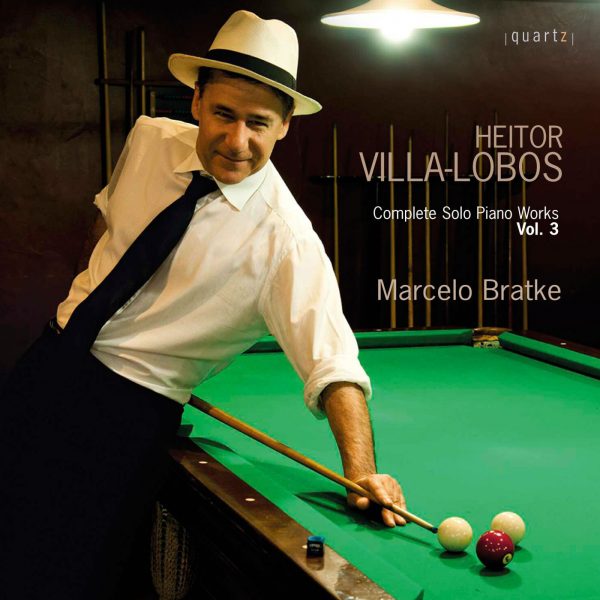Heitor Villa-Lobos: Complete Solo Piano Works, Vol. 4 & 5
Price range: £7.99 through £14.99
On this release, Marcelo Bratke continues his journey through the complete Villa-Lobos solo piano works. This release features volumes 4 and 5, and includes Villa-Lobos’ Guia Prático Albums 1-11. During a decade of extraordinary accomplishments and performances, Marcelo Bratke, one of Brazil’s preeminent pianists, has performed at some of the world’s most renowned venues, including Carnegie Hall, the Salzburg Festival, Queen Elizabeth Hall, Wigmore Hall, and the Konzerthaus in Berlin. In recent years, he has become increasingly focused on how the arts can engage in politics and help contribute to improvements in society. “The Villa-Lobos pieces played by Mr. Bratke at the start were best of all, offering hints of wildness, yet with elegant construction, subtle rhythmic dislocations and shining piano colors. … Mr. Bratke is a fine and flexible pianist, perfectly happy either to play Bach or to plunge into the popular music he set next to it.” (The New York Times)
About This Recording
Although Brazilian composer Heitor Villa-Lobos (1887–1959) never had any children of his own, the world of infancy has always been a powerful inspiration for his works. Scores, inspired by children spread throughout his whole output, from some of the earliest examples we listen to in this volume until his last opera, A Menina das Nuvens (The Girl of the Clouds), finished in 1958 and posthumously premiered in 1960. In addition to this, this recording also pays tribute to Villa-Lobos’ outstanding achievement as a musical educator in Brazil, with the composition of Guia Prático (Practical Guide), that perhaps might be seen as a kind of a Brazilian response to Hungarian Béla Bartók’s Mikrokosmos.
The disc opens with one of Villa-Lobos’ earliest piano pieces, Petizada (which could perhaps be translated as The Little Brats), written in 1912 – the year he met Lucília Guimarães, whom he would eventually marry in 1913. It is usually accepted that Lucília, a pianist with a solid background, would improve much of Villa-Lobos’ knowledge of the keyboard, as well as his writing for the instrument. So here we have a rare sample of what his pianism was like before his first wife’s advice. Petizada is a small collection of six miniatures inspired by children’s games and legends: No.5, Saci, refers to one of the most popular Brazilian legends, a one-legged black youngster with holes in the palms of his hands, who smokes a pipe and wears a magical red cap that enables him to disappear and reappear, while No.6, História da caipirinha (Story of Little Peasant Girl) is dedicated to the composer’s daughter-in-law, Izaht.
Next comes another short cycle, 1919’s Histórias da carochinha – a Portuguese expression for children’s tale, which literally reads as Little Cockroach Stories, as Lady Cockroach’s Wedding is one of the most popular Brazilian fairy tales.
There’s no cockroach involved in Villa-Lobos’ cycle, though; its four short pieces deal with an enchanted palace, a prince, a princess and a shepherdess. Then we come back to 1912, with Brinquedo de Roda (Round Games), a selection of six well-known Brazilian nursery rhymes. In Portuguese, Round Games are also called cirandas – so this might be seen as an early sample of a world Villa-Lobos would exploit in a much more ambitious way in his Cirandinhas (1925) and specially in the flamboyant Cirandas (1926).
The three relatively unpretentious suites we have heard so far were written by Villa-Lobos in Brazil, before his life changing trips to Paris, in the Roaring Twenties. When he came back from France, he found the country in political turmoil: the 1930 Revolution ended the exclusive domination of the states of São Paulo and Minas Gerais, bringing to power a politician from the South, Getúlio Vargas.
In 1931, the Vargas regime decreed the introduction of choral singing – Canto Orfeônico – into the Brazilian educational system, and Villa-Lobos was the man to lead the initiative, creating, in 1932, the Sema (Superintendence of Musical and Artistic Education). He led gigantic propaganda concerts in football stadiums, assembling students, teachers, soldiers and workers, and also engaged qualified personel to spread musical education all over the country. From 1933 to 1941 no less than 3,000 teachers received their diplomas from Villa-Lobos’ scheme. As Eero Tarasti wrote, “he turned to the great masses of Brazil and set about preparing programs for the musical development of totally unschooled, even illiterate people. Villa-Lobos truly believed in the omnipotence of music as an educational tool, and it was the lack of education he considered to be the root of all Brazil’s problems”. On a more personal level, Villa-Lobos by that time met the young Arminda Neves d’Almeida, who was to become his second wife.
Villa-Lobos informed Lucília he was going to leave her in 1936, whilst returning from Europe. In this trip, he held a music education conference in Prague, announcing he had conceived a Guia Prático for artistic and musical education in six volumes. The project remained unfinished; Villa-Lobos concluded only the first volume, with 137 vocal pieces consisting of children’s folk tunes.
How did these choral works become piano pieces? Brazilian musicologist Luiz Heitor Correa de Azevedo explains: “several of these tunes have been endowed with a piano part which far from being mere accompaniments, make up a genuine independent piece, which can be performed on its own. Pianists have certainly made the most of this opportunity, adopting several of them for their concert programmes. Thus it was that these miniature works, intended for the schoolroom, finally ended up in the concert hall and were published in Rio, Paris and New York as piano music, in their own right, lifted right out of the didatic context to which they originally belonged”.
Between 1932 and 1949, Villa-Lobos published 59 pieces of the Guia Prático as piano pieces, in 11 albums. Some of them are dedicated to really outstanding pianists as Arnaldo Estrella (Album No.3), Magdalena Tagliaferro (Album No.4), Anna Stella Schic (Album No.5), William Kapell (Album No.6) and Mieczyslaw Horszowski (Album No.11). These names give account of the technical skills required to play these pieces – like Debussy’s Children’s Corner, or Schumann’s Kinderszenen, they are child-inspired but not child-oriented.
—Irineu Franco Perpetuo
Track Listing
-
- Petizada...1. A Mão Direita tem uma Roseira
- ...2. Assim Nimava Mamãe
- ...3. A Pobrezinha Sertaneja
- ...4. Vestidinho Branco
- ...5. Saci
- ...6. A História da Caipirinha
- Brinquedo de Roda...1. Tira o seu Pezinho
- ...2. A Moda da Carranquinha
- ...3. Os Três Cavalheirozinhos
- ...4. Uma, duas Angolinhas
- ...5 Garibaldi foi à Missa
- ...6. Vamos Todos Cirandar
- Histórias da Carochinha...1. No Palácio Encantado
- ...2. A Cortesia do Principezinho
- ...3. E o Pastorzinho Cantava
- ...4. E a Princezinha Dançava
- Guia Prático Album 1...1. Acordei de Madrugada
- ...2. A Maré Encheu
- ...3. A Roseira
- ...4. Manquinha
- ...5. Na Corda da Viola
- Guia Prático Album 2...1. Brinquedo
- ...2. Machadinha
- ...3. Espanha
- ...4. Samba Lelê
- ...5. Senhora Dona Viúva
- Guia Prático Album 3...1. O Pastorzinho
- ...2. João Cambuête
- ...3. A Freira
- ...4. Garibaldi foi à Missa
- ...5. O Pião
- Guia Prático Album 4...1. O Pobre e o Rico
- ...2. Rosa Amarela
- ...3. Olha o Passarinho, Dominé!
- ...4. O Gato
- ...5. Ó Sim
- Guia Prático Album 5...1. Os Pombinhos
- ...2. Você diz que Sabe Tudo
- ...3. Có Có Có
- ...4. O Bastão ou Mia Gato
- ...5. A Condessa
- Guia Prático Album 6...1. Sonho de uma Criança
- ...2. O Corcunda
- ...3. Carangueijo
- ...4. A Pombinha Voou
- ...5. Vamos Atrás da Serra, Oh! Calunga!
- Guia Prático Album 7...1. No Fundo do meu Quintal
- ...2. Vai, Abóbora
- ...3. Vamos, Maruca
- ...4. Os Pombinhos
- ...5. Anda à Roda
- Guia Prático Album 8...1. Ó Limão
- ...2. Carambola
- ...3. Pobre Cega
- ...4. Pai Francisco
- ...5. Xô! Passarinho!
- ...6. Sinh'Aninha
- ...7. Vestidinho Branco
- Guia Prático Album 9...1. Laranjeira Pequenina
- ...2. Pombinha, Rolinha
- ...3. Ó Ciranda, Ó Cirandinha
- ...4. A Velha que Tinha Nove Filhas
- ...5. Constante
- ...6. O Castelo
- Guia Prático Album 10...1. De Flor em Flor
- ...2. Atché
- ...3. Nesta Rua
- ...4. Fui no Itororó
- ...5. Mariquita Muchacha
- ...6. No Jardim Celestial
- Guia Prático Album 11...1. O Anel
- ...2. Nigue Ninhas
- ...3. Pobre Cega
- ...4. A Cotia
- ...5. Vida Formosa
- ...6. Viva o Carnaval




